How Great is Cate? We Find out as we dig Into her Unseen Filmography!
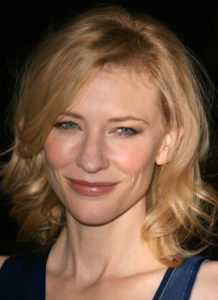
One of the most wonderful parts of film consumption is discovering new favorites, whether it be a new film that challenges you or helps you escape or the anticipation of seeing the next film in a series or starring one of your favorite actors or actresses.
But there’s another type of discovery too, the one that you aren’t even conscious of until you look you take a step back and take in the full picture. My appreciation of Cate Blanchett is that type of discovery, the kind that was right there in front of my face, but that I didn’t even realize until I really looked at her full work; only then discovering that I’m kinda a huge Cate Blanchett fan, and I’m guessing that is going to be the case for most people.

Blanchett possesses that quality was indicative of the greats in the golden age of cinema. She’s timeless or at least feels that way, even though it was only 1998 when she made her mark as the titular role in Elizabeth. Yet in that 20-something years, Blanchett has made crossed genre (and gender) to establish herself as one of the finest actresses of our time. She’s self-possessed and commanding. There’s a reason why her films are quick to showcase her unnerving stare, her mouth set in a way that gives away nothing.
Although Elizabeth and its 2007 sequel, Elizabeth: Golden Age, will forever be one of her most iconic roles, Blanchett is more than just formal regality. There’s the ethereal grace, power, and even horror of Galadriel in Peter Jackson’s Lord of the Rings films. Her quirky, disillusioned yet contemplative Bob Dylan in I’m Not There stands out as an example of her ability range. If her more serious films like Babel, Blue Jasmine, Notes on a Scandal, while all demonstrating her skill, aren’t your taste, Blanchett fortunately has never had a period where she was stuck in one genre. She’s equally as good in lighter fare, like the heist caper Bandits or Wes Anderson’s Life Aquatic with Steve Zissou, revealing that she knows comedy as well as drama. There’s no greater example of this than her cameo in Edgar Wright’s homage to action films, Hot Fuzz.
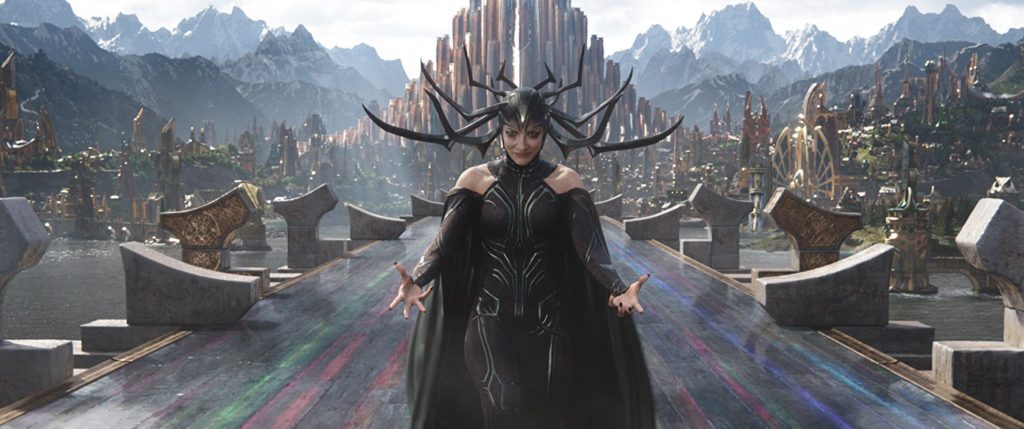
Just as in genre, Blanchett is not slave to the side of do-gooderism. Her villainous role in the underrated (yes, I said it) Indiana Jones and the Kingdom of the Crystal Skull is hammy villainy at its best. She is a wonderfully evil stepmother in Cinderella and sister in Thor: Ragnarok, breaking her brother’s favorite favorite. Even when she isn’t on screen, Blanchett brings gravitas and emotion to her roles. Her role as Hiccup’s mother, Valka, in the How to Train Your Dragon movies is poignant and full of motherly regret, pride, and strength.
Whether you know her from these roles or are only now realizing her versatility and coming to the same realization I did, we are all Cate Blanchett fans. She is actress of all seasons, and I invite everyone to continue to grow in appreciation of her films. I’m sure she will continue to surprise and impress us whatever the film.
– Oscar Jackson III
Elizabeth
1998, Polygram Filmed Entertainment, dir. Shekhar Kapur
by Erik Yates
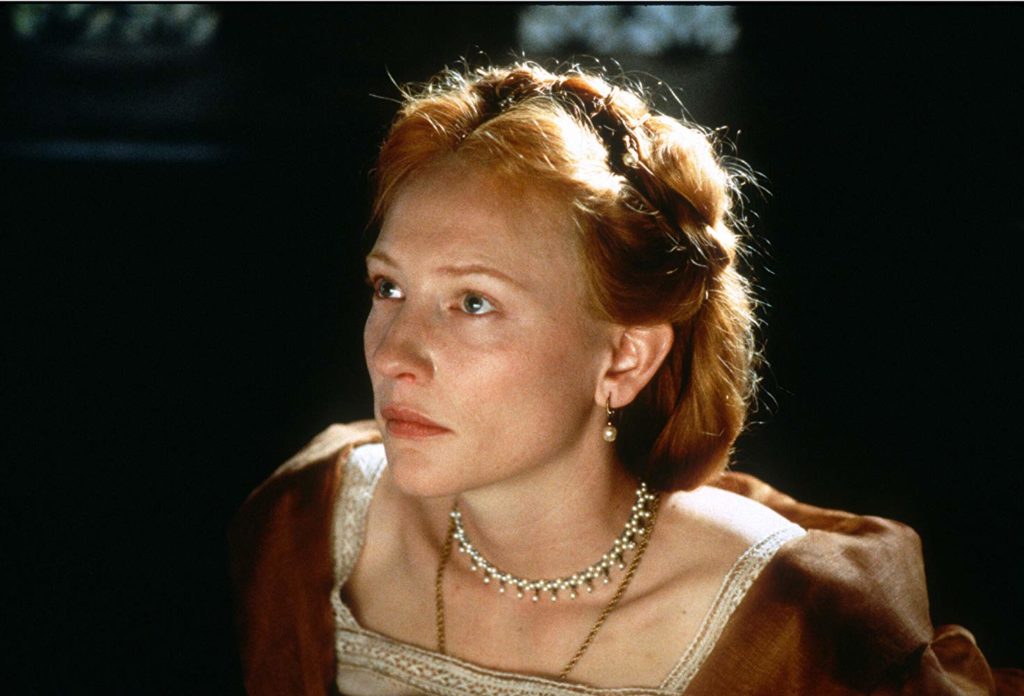

Cate Blanchett is a brilliant actor and a virtual chameleon, as she is able to consistently blend into every role she plays, completely erasing herself, and taking on the character, story and setting of the film and story she is trying to play. Based on 1998’s Elizabeth, this is a skill she has possessed now for over 20 years. While she has: played an Elf Queen in the Hobbit/Lord of the Rings trilogies, the evil ruler of Asgard and Thor’s vile sister in Thor: Ragnarok, broken cultural taboos in Carol, become both Katherine Hepburn and Bob Dylan, done voice work in How to Train Your Dragon and The Family Guy, and shown up in films by Wes Andersen, and Edgar Wright, it was still an early film in her career that continues to dodge me. That film was Elizabeth, in which Cate Blanchett played the infamous Queen Elizabeth I. Happily, I’ve now rectified this giant hole in my Blanchett filmography, though I must admit I still need to now view its sequel, Elizabeth: The Golden Age.
Due to waiting until 2019 to see this 1998 film, my most recent cinematic experience with Elizabeth I was Mary Queen of Scots, where Margot Robbie played the Queen who would forsake marriage to a man, to embrace her marriage of sorts to England itself. While Robbie did a fantastic job, it is still obvious some 21 years after the fact that Cate Blanchett still truly owns this role. She is able to play the still teenaged Elizabeth at the start of the film, and mature over the course of the film despite very little time lapse occurring in the narrative. Largely, Cate Blanchett is able to accomplish this through her eyes. No matter what Mrs. Blanchett’s actual age is in real life, she has been able to vacillate between roles that require youthful exuberance and resolve, like her turn as Hela in Thor: Ragnarok where despite playing a character that’s lived for millennia, she was quite young looking, decked out in tight leather costumes and waging war, to older, wiser characters like Galadriel, or even as Florence Zimmerman in The House with a Clock in Its Walls, and her award winning role in Blue Jasmine. All of this through what she conveys with the subtlest of eye movements and reactions that convey so much of her character’s strengths, weaknesses, knowledge, vulnerabilities, and depth. It is a gift that serves her well, no matter the strength of the film itself.
Cate Blanchett is a modern day treasure, and will one day be looked upon as Hollywood royalty in much the same way that Meryl Streep is today. This is due to being a master of her craft, and her ability to imbue each role with a quality of excellence that elevates every project she touches. Elizabeth is a great primer and example of Cate Blanchett’s earlier work, but go in knowing that any other film she is in will bring the same quality of excellence in acting, as far as it relates to her. While there are a few more holes of her filmography I still need to catch up on, Elizabeth only reminded me that I need to be about that sooner, rather than later.
Blue Jasmine
2013, Gravier Productions, dir. Woody Allen
By Jeffrey Knight
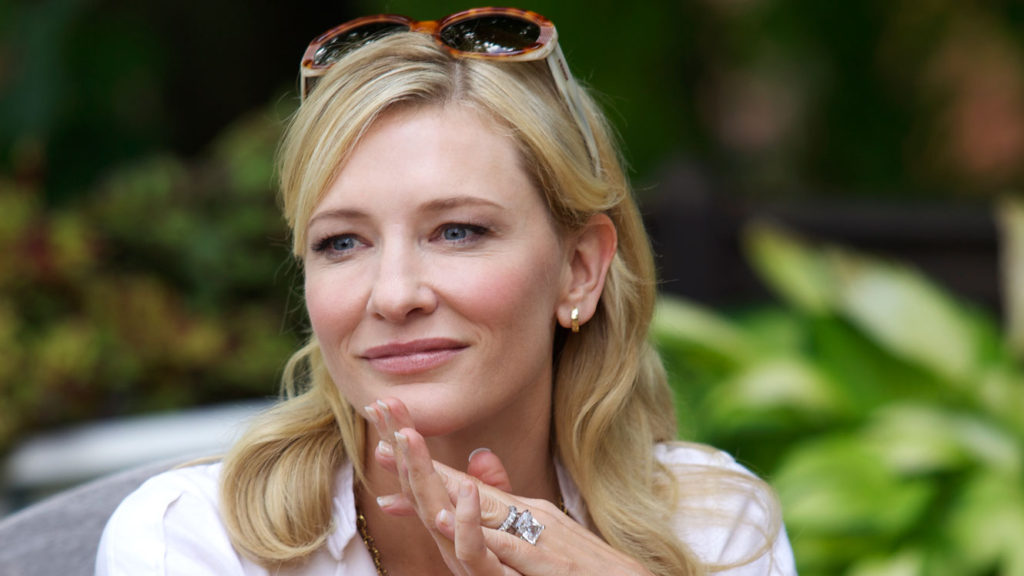
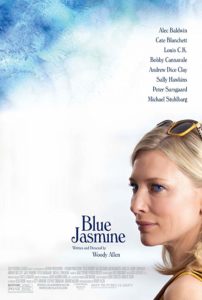
We’ll get to the elephant in the room in just a moment, but let me start out by saying that boy, oh boy, is Cate Blanchett good in this movie. She won an Oscar (her second, but her first for a leading role), a Golden Globe, BAFTA awards, Screen Actor Guild Awards, and more. All deservedly so, since the role is an actor’s showcase, and Blanchett knocks the big, showy scenes right out of the park.
Blanchett plays “Jasmine” Francis (real name: Jeanette) who has moved from New York City to San Francisco to live with her sister. Jasmine is used to a lavish, upper-class lifestyle but has recently hit upon hard times leaving her nearly destitute. She’s not happy having to slum it with her low-wage sister, Ginger (Sally Hawkins) and hates Ginger’s ill-mannered, working-class boyfriend Chili (Bobby Cannavale). Jasmine wants to get a job as an interior designer, but needs to learn computer skills before she can take the online certification classes needed for that. In the meantime, she gets a job as a receptionist for a dentist (who sexually harasses her- yes, yes, we’ll get to that), and pushes her sister to dump Chili and find a better man. Jasmine meets a diplomat at a party, played by Peter Sarsgaard, and the two begin a serious relationship. The problem is that Jasmine has completely lied about her past to him (the full story of which the audience learns in flashback throughout the movie), and she’s prone to heavy drinking, abusing anti-anxiety medicine and fugue-like episodes where she seems to forget where and when she really is.
And through all of it, Blanchett plays Jasmine’s deteriorating mental state perfectly. Yes, she has the moments where she breaks down, yells, screams and cries; the sorts of moments that look great on any actor’s demo reel. But she nails all the in-between stuff too. Jasmine is in no way a likable or aspirational character. She is in turn haughty, dismissive, arrogant and dishonest to everyone she meets- even the people she claims to love. Her actions have effects that hurt people’s lives. But thanks to Blanchett, we still retain empathy for Jasmine. In between all of the fireworks is an actor working to sustain her character and to show us how her thought processes lead her to where she ends up. When Jasmine fails at her goals, we still feel bad for her, even as we’re relieved for everyone else. It’s an absolutely incredible performance- a career-best for Blanchett so far, and you know that’s saying something.
But now we must talk about that other matter. This article is meant to praise Cate Blanchett and not bury Woody Allen. Allen wrote and directed Blue Jasmine, and its unmistakably a Woody Allen film in style and tone. That casts an unfortunate pall over the whole thing (especially with the dentist scene above, and then more so when Louis C.K. appears as a potential boyfriend for Ginger). But the movie is fully Blanchett’s show. She reportedly developed the character with little input from Allen, and Allen’s personal actions shouldn’t cancel Blanchett’s phenomenal work here. Blanchett has always been a consistently great actor- but she flowers so vividly in Blue Jasmine.
Manifesto
2015, Filmrise, dir. Julian Rosefeldt
By Krystal Lyon
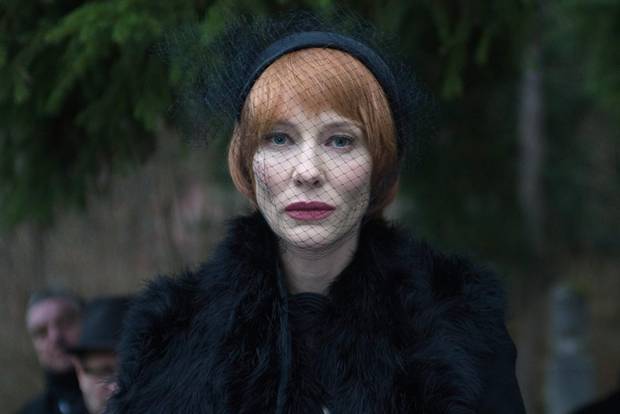
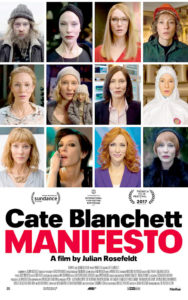
I had no clue what I was in for with Manifesto. All I knew before watching it was our birthday girl Cate Blanchett played thirteen different roles. But Manifesto is not Blanchett giving Eddie Murphy and The Nutty Professor a run for their money. (And I used that plural correctly.) No it’s nothing like that, but there are some funny parts depending on your knowledge of art, political theories and philosophy. Actually, I’m not sure how to classify this film, other than though provoking and visually stunning theater vignettes. Are you confused? So was I, let’s begin.
Manifesto is the brainchild of director Julian Rosefeldt and started out being an art installation. He pieced together twelve different monologues from different manifestos given by leaders of twelve different movements in history including Dadaism, Futurism, Surrealism and minimalism. Art, culture, politics and humanity are all central to each monologue and each one is profound. For the delivery of those monologues, Rosefeldt sets up twelve normal everyday scenarios, a teacher and her third grade class, a lady giving a eulogy at a funeral, a conservative mother saying a prayer before dinner, a paranoid homeless man shouting at no one and this is where the humor comes in. Many times the stage that is set and the character that’s delivering the monologue have absolutely nothing to do with the words that are being said. It’s comical to hear the passions of the Dada movement shouted during a funeral, or the thoughts behind the eccentric pop art movement said as a prayer before dinner. It’s the odd mix that sticks in your brain and makes you think about what’s being said and the everyday people living in the world those ideologies are creating. I know all of that sound weird and conflicting but that weirdness is the reason you should give Manifesto a try!
I’m also recommending Manifesto because everyone was on his or her A-Game for this production. With music from the great Nils Frahm and the beautiful cinematography of Christoph Krauss, Manifesto feels like a decadent piece of art! And I’m going to mention the location scout, Roland Gerhardt, because you will start planning a trip to Berlin based on the backdrops of this film! (I just did.) And speaking of A-Game, Blanchett is second to none! Using accents, tone, emotion and inflection you forget that it’s just Cate and not an entire troupe of actors. She uses a soft southern accent during a prayer and in the next scene she’s a punk cockney shouting at a band rehearsal. She carries her body and weight differently for each character; it’s incredible how she transforms! My favorites include a single mom working at a garbage incinerator plant and a choreographer that’s giving off some major Joan Crawford vibes. She is untouchable and totally approachable all in one ninety-minute film. Blanchett is sublime and you can’t wait to see what person she will inhabit next!
For me (I dabble in art) Manifesto was a total home run, and it’s a film I want to talk about and recommend. I didn’t think I could love Blanchett more but knowing she shot all of this in twelve days in the same year she did Thor: Ragnarok is quite impressive. If you love Cate The Great, art, theater, philosophy or you just want to watch beautiful cinema then check out Manifesto soon!
I’m Not There
2007, Killer Films, dir. Todd Haynes
By Jim Tudor
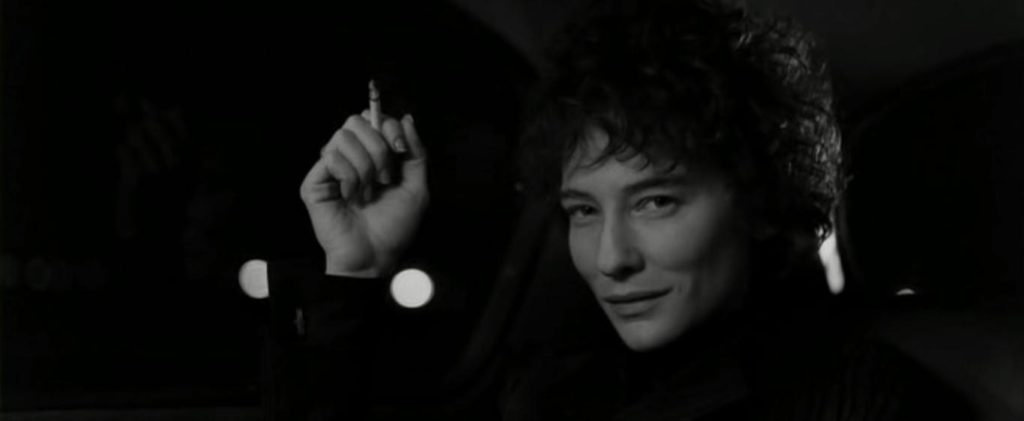

The term “fan service” is something that’s been relegated primarily to the blockbuster realm of comic book movies and Star Wars. But in the case of Todd Haynes’ 2007 bravura oddball I’m Not There, hardcore Bob Dylan fans find something served up just for them, and most generously. Right down to its title, taken from one of the singer/songwriter’s most notoriously unreleased songs (these legendary “The Basement Tapes” sessions, featuring Dylan and The Band, have since been officially released, and are highly recommended) I’m Not There operates so deeply and firmly within the realms of biographical Dylan esoterica and mythology that relegating it as “one for the fans” would be an understatement.
Thankfully, I’m no slouch in the Bob Dylan department. It’s hard to know, though, how I would’ve fared in 2007, when Todd Haynes went for broke with this most unconventional of musician biopics. In fact, it feels kinda wrong to call this a “musician biopic” at all. Rather than go the tired and conventional (if also tried and true) route with a rote and linear presentation of recreated facts, Haynes embraces the self-concocted enigma of Bob Dylan (who, by the way, as David Letterman says, IS the greatest living songwriter), boldly grafting it to cinema. There are probably a thousand other ways to do such a thing, but this is the version that got made. Again though, thankfully, it’s pretty darn great. At times, even astonishing. Intimidating? Yes, that too.
Utilizing six very different actors to embody different versions of Dylan throughout his life (“Inspired by false stories”), Haynes demands that even the most entrenched fan work while watching this two-hour and fifteen minute opus. Each version has a different name and even a different personality, existing in different times and places either realistically recreated and/or made up. (And in some cases, based loosely upon the cinema of various auteur filmmakers that Dylan’s keyed into at certain times: Fellini, Godard, Peckinpah…) At times the divergent chapters seem to overlap, co-existing in one another’s realities.
To further complicate matters, each Dylan surrogate is depicted as a different person, complete with their own name, personality, environment, aesthetic, and outward appearance. The grandest of casting liberties are taken, as we’ve got young and black Marcus Carl Franklin portraying the train hopping guitar toting Woody Guthrie-esque childhood persona, Ben Whishaw looking more like Robert Smith from The Cure, Heath Ledger acting out the Blood on the Tracks divorce drama, Richard Gere as a fantastical psychedelic Western faux Billy the Kid persona (“Knockin’ on Heaven’s Door”), Christian Bale in a duel role as “Jack”, who becomes born again Christian “Pastor John” (Slow Train Coming, Saved, etc.), and most crucially, Cate Blanchett as Jude.
The Jude persona is the only one that is, by design, intended to resemble the real Bob Dylan. And boy, does she. Blanchett, supposedly with a sock in her trousers to help her walk like a man, got nominated for an Academy Award for this spot-on performance. She embodies the egomaniacal mid-1960s Dylan as he careened all over London, confounding reporters, chain smoking, and hanging with Allen Ginsberg (David Cross) and basically cutting down anyone in his path. I don’t know whose idea it was to plug Blanchett into this most prominent of roles, but it’s rather ingenious.
For non-fans of Bob Dylan, I’m Not There is likely to play as anywhere in-between insurmountable and insufferable. But even they must admit that through their confusion, there isn’t one second of this film that doesn’t proclaim an unerring directorial confidence. Not even Dylan’s own brilliant career can share that boast. That said, six Dylans is never better than one, even when one is the outstanding Cate Blanchett.
The Talented Mr. Ripley
1999, Miramax, dir. Anthony Minghella
By Taylor Blake
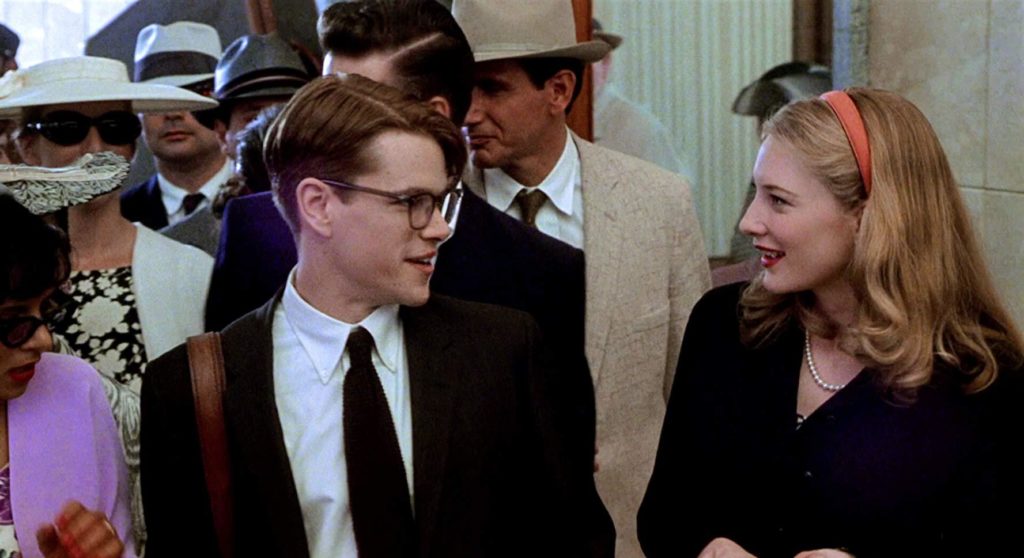
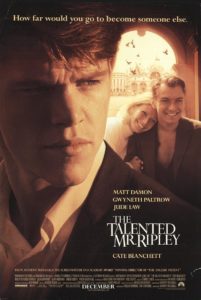
My first introduction to Cate Blanchett came when she donned the elven crown as Queen Galadriel in The Lord of the Rings. Unnaturally tall, otherworldly, and ageless, Galadriel is the first to show us of the temptation of the One Ring’s dark magic. Of course, it helps that Cate Blanchett herself is tall, otherworldly, and ageless, but that’s not the only reason she convinced us to believe in her fantasy character.
She also brought a cool, detached perspective that she showed again as a con woman in Ocean’s Eight. Her boldness to tap into our darker natures served her well as a villain in the Indiana Jones and Thor franchises. She played that same vulnerability as Katharine Hepburn in The Aviator and even as an Evil Stepmother in Cinderella.
But taking a trip back in her canon for this Film Admissions, I discovered a side of her that she seems not to have dusted off in awhile: The Innocent. Like many of the characters in The Talented Mr. Ripley, she underestimates Matt Damon’s budding sociopath. But while Gwyneth Paltrow is distracted by his self-pity and Jude Law is blinded by his own arrogance, Blanchett’s American heiress is wrapped in naïveté. Still young enough to be courted by her parents around Europe but old enough to complain about their cocoon, she will believe whatever a handsome young man tells her at first meeting. She wears her bangs pulled back in a headband, a string of pearls around her neck, and rosy glasses that her privilege has kept high on the bridge of her nose. But is it ingratiating? Not when Blanchett makes the source of all this gullibility her kind heart, one that will go out of its way to comfort a stranger and seek decency in a scandal.
For all the light Galadriel brought to dark places, I’ve yet to see Blanchett play another character like this one. Then again, I’ve also yet to see her play a role that doesn’t convince me of its authenticity.
Veronica Guerin
2003, Touchstone Pictures, dir.Joel Schumacher
By Sharon Autenrieth
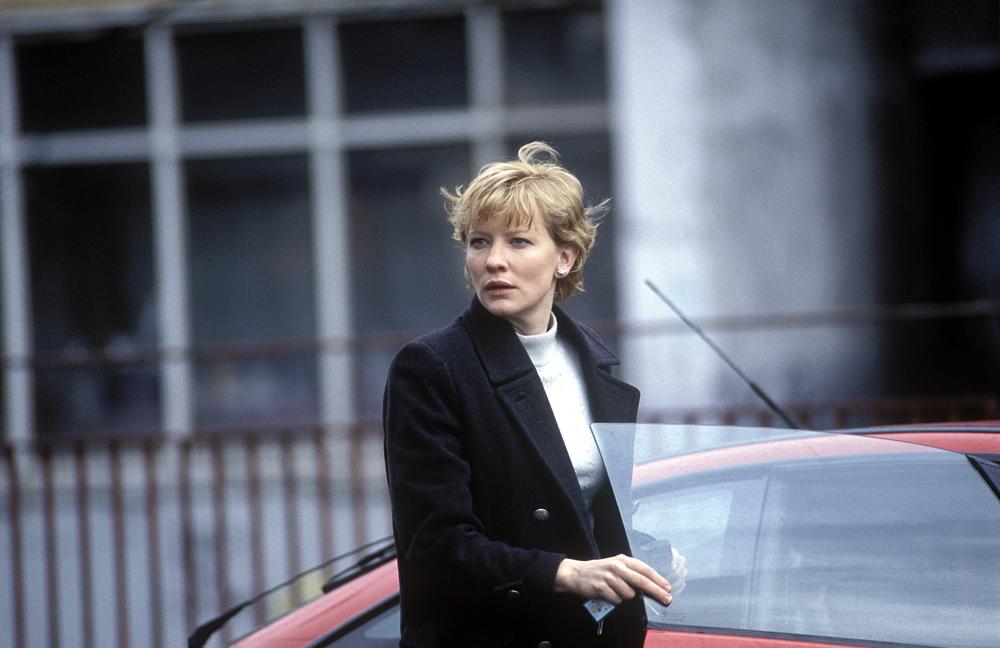
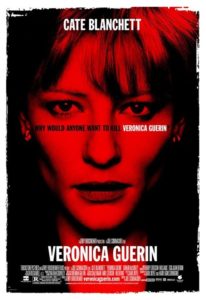
The real Veronica Guerin is a heroic figure in Ireland, a martyr who died fighting the drug trade. Guerin was a reporter who persisted in exposing criminals she believed were destroying her city, Dublin, even after she had been threatened, beaten, and shot in one failed assassination attempt. The hitmen didn’t fail twice, and Guerin’s 1996 murder was a catalyst for the Irish government to crack down on the drug trade.
It’s such a promising story, and with the great Cate Blanchett playing Guerin it seems like a can’t-miss. But it is a miss, and a mess. Director Joel Schumacher handles this biopic in such a prosaic way that it comes off like an educational film, or a middling crime-reenactment show. The fault certainly can’t be laid at the feet of Blanchett, a tremendously gifted actress. But even her performance is off here, as if Schumacher gave Blanchett one direction and one direction only for her portrayal of Guerin: “Make it plucky.” The result is an attempt at hagiography that makes the saint seem simply reckless. Guerin cheerfully confronts drug lords in their homes as if she’s invincible, threatens people who she knows are capable of murder, waves off the concerns of her friends and family – even after she’s been shot in her own home. Schumacher never gets below the surface, so this behavior seems less like courage and more like foolishness. Blanchett’s Guerin responds to the most dangerous criminals with winks, sly grins, and jokes. She seems genuinely shocked when they respond with violence.
After watching Veronica Guerin I read a tribute to the journalist by one of her colleagues. She described Guerin’s concern for the world in which her young son would grow up, her desire to fight the drug trade for his sake. That motive never really comes across in Veronica Guerin. What the movie leans on is a trope for female journalists onscreen – that Guerin was tired of doing light, human interest topics and wanted to do a real, hard-hitting story. In an attempt to honor Guerin, Schumacher has managed to flatten her and reduce her to a stereotype.
Veronica Guerin lacks any visual style and is so wooden that it almost put me to sleep twice – and I adore Cate Blanchett. Its only strong suit is in a few of the supporting performances: Brenda Blethyn as Veronica’s mother, a brief (extraneous, but charming) cameo by Colin Farrell, and especially Ciarán Hinds as a criminal informant with whom Veronica has a complicated relationship.
The real Veronica Guerin deserves a better movie than this one. Maybe we could give Saoirse Ronan a few years to age into the role, and get a director with some depth to take on the story. This 2003 version of her life is best forgotten.
The Missing
2003, Revolution Studios, dir. Ron Howard
by Oscar Jackson III
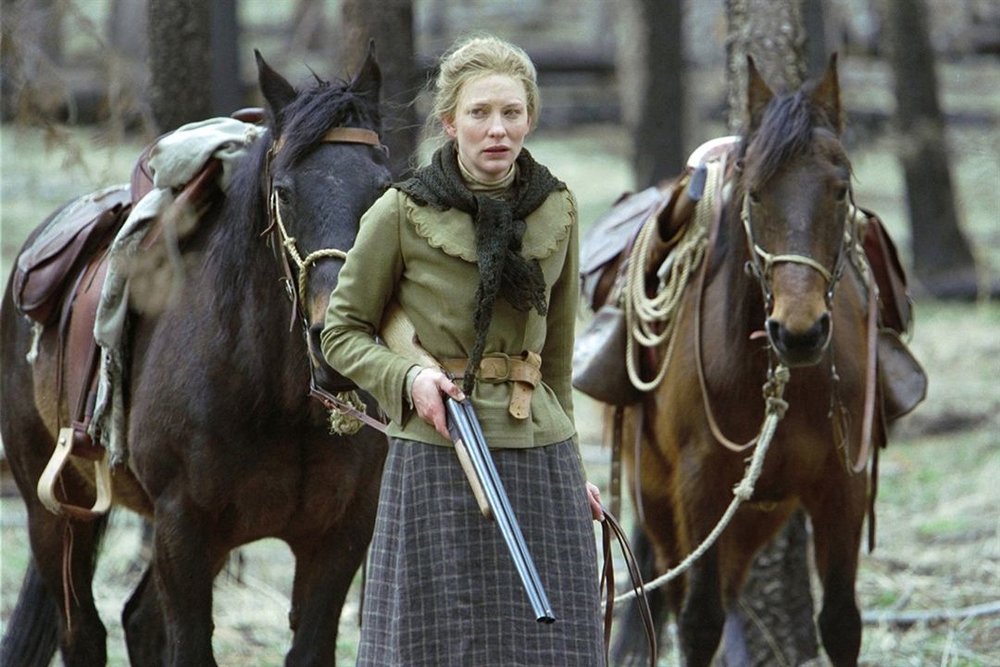
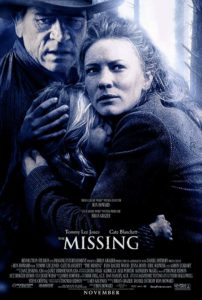
I’m a sucker for westerns. Some of it is nostalgia as I can recall going to my grandparents farm and the only option for watching was an endless stream of Gunsmoke, Rawhide, and Bonanza episodes or rewatch the expansive John Wayne VHS boxset they owned. But it isn’t just about the nostalgia. Westerns, more than any other genre in my opinion, excel in making the land, the great plains and plateaus of the Midwest United States, a character in the film. Directors like Howard Hawks and Sergio Leone use the land to instill and heighten the wonder, desperation, harshness and beauty of stories played out in that untamed land. No one did this better, though, than John Ford. It is clear that The Missing’s director Ron Howard (who actually starred in one of Ford favorite John Wayne’s final pictures, The Shootist), is following in Ford’s footsteps and especially the film, The Searchers.
Cate Blanchett plays Maggie, a woman strong enough to survive in the West, but not comically so. Protagonists in some westerns shrug off the hardships, exhibiting an unrealistic resilience to the harsh lives they lead, but Blanchett’s Maggie conveys the toll that life has exacted on her. From the early loss of siblings, a father that was non-existent, and her present occupation of frontier doctor, nothing has come easy. Yet despite that Maggie presents stalwartly forges ahead for the sake of her two daughters, even finding some un-Christian romance with one of her workhands.
This is interrupted when her absent father, Samuel Jones (Tommy Lee Jones), shows up. Unwilling to forgive him, Maggie wants nothing to do with him until her eldest daughter, LIlly (Evan Rachel Wood) is taken by a group of men led by a fearful shaman (Eric Schweig) to be sold to the sex trade. Forced to rely on her father, the film follows Maggie and her youngest daughter and Samuel’s pursuit to get Lilly back before it is too late.
Once again, Blanchett brings balance to her to role. She is capable but not to a distracting level. More than anything it is clear that Maggie refuses to do what her father did and give up on family. This is made harder by the fact that everyone around her fails her, including an inept local sheriff and a calvary force more interested in looting and forcing the relocation of a group of elderly Native Americans. Where so many find it easy to abandon the right thing, Maggie does not give up and at one point says she wouldn’t know how to abandon her daughter, showing that she is not going to continue her father’s deserting ways.
Tommy Lee Jones is fine as Samuel Jones, being one of those wandering souls who doesn’t realize the hurt his lifestyle has caused more from ignorance than maliciousness. He admits that the whole reason he came back has to do with a shaman’s advice following a snake bite more than remorse. The father/daughter interaction is predictable but never becomes saccharine.
While Howard is never able to ascend to the heights of Ford, he does a fine job guiding the story. His West is more harsh than majestic, though there are glimpses of that beauty. The sins and failures of the US are present in regards to treatment of Native Americans is present as is more common today than in past westerns, which brought the film some criticism, which I think is unfounded. At the same time, it feels like an older movie than it is, though it was only released in 2003. That may have to do with Westerns always feeling like a relic of the past as they no longer have the attraction they once did. It is interesting despite that that some of the more prolific modern directors have tried their hand at the genre that has clearly shaped their filmmaking education ( see Quentin Tarantino, Antoine Fuqua, or James Mangold)
There are echoes of Wayne’s Ethan Edwards in Maggie, but The Missing isn’t about Maggie denying her humanity and connection with people to do what has to be done. Instead, it about her holding on to it despite ample reasons, some good and some not, to give up and surrender to apathy or bitterness. It is a largely joyless affair, but never tedious or boring.
I wouldn’t want to live at this point in human history, but I continue to appreciate its ability to highlight the human experience. Shaking things up by highlighting a female protagonist is a welcome change, while maintaining much of what makes the genre iconic.


